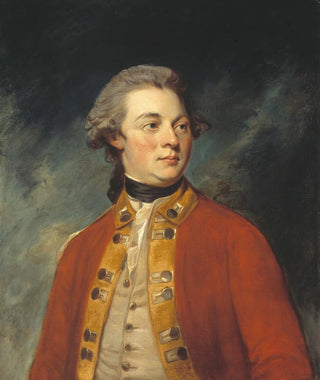Art print | Portrait of Francis North, 4th Earl of Guilford, 1761-1817 - George Romney


View from behind

Frame (optional)
Portrait of Francis North, 4th Earl of Guilford, 1761-1817 - George Romney – Captivating Introduction
The portrait of Francis North, 4th Earl of Guilford, painted by George Romney, is an iconic work of the eighteenth century, a period when portrait art experienced unprecedented growth. This painting, which captures the essence of a man of power and distinction, immerses us in a universe where the English aristocracy reveals itself in all its splendor. Through the delicate features of the earl, the artist manages to transcend a simple portrait to offer a true psychological study, blending elegance and depth. The depiction of North, with his penetrating gaze and resolute attitude, invites the viewer to explore the subtleties of his character while reflecting the values and aspirations of his era.
Style and uniqueness of the work
George Romney's style is distinguished by an impressive mastery of colors and textures, which give his portraits an almost lifelike dimension. In the case of Francis North, the artist uses a subtle palette, where warm tones and delicate shadows create an intimate atmosphere. The rendering of the clothing, richly detailed, not only indicates the social status of the earl but also demonstrates Romney's skill in capturing light and movement. Each brushstroke seems to tell a story, adding a narrative depth to the work. The composition, centered on the earl's face, allows focus on his expressions, thus revealing a complex personality, both charismatic and introspective. This portrait is not merely a simple representation; it becomes a mirror of the aspirations and dilemmas of a time marked by social and political changes.
The artist and his influence
George Romney, a central figure of eighteenth-century British art, established himself through his innovative approach to portraiture. Trained in the painting style of the great masters, he drew inspiration from the techniques of his predecessors while developing a personal style that is uniquely his own. His ability to capture the individuality of his subjects and translate it onto the canvas allowed him to secure a prominent place among his contemporaries. Romney not only influenced his peers, but his work continues to influence

Matte finish

View from behind

Frame (optional)
Portrait of Francis North, 4th Earl of Guilford, 1761-1817 - George Romney – Captivating Introduction
The portrait of Francis North, 4th Earl of Guilford, painted by George Romney, is an iconic work of the eighteenth century, a period when portrait art experienced unprecedented growth. This painting, which captures the essence of a man of power and distinction, immerses us in a universe where the English aristocracy reveals itself in all its splendor. Through the delicate features of the earl, the artist manages to transcend a simple portrait to offer a true psychological study, blending elegance and depth. The depiction of North, with his penetrating gaze and resolute attitude, invites the viewer to explore the subtleties of his character while reflecting the values and aspirations of his era.
Style and uniqueness of the work
George Romney's style is distinguished by an impressive mastery of colors and textures, which give his portraits an almost lifelike dimension. In the case of Francis North, the artist uses a subtle palette, where warm tones and delicate shadows create an intimate atmosphere. The rendering of the clothing, richly detailed, not only indicates the social status of the earl but also demonstrates Romney's skill in capturing light and movement. Each brushstroke seems to tell a story, adding a narrative depth to the work. The composition, centered on the earl's face, allows focus on his expressions, thus revealing a complex personality, both charismatic and introspective. This portrait is not merely a simple representation; it becomes a mirror of the aspirations and dilemmas of a time marked by social and political changes.
The artist and his influence
George Romney, a central figure of eighteenth-century British art, established himself through his innovative approach to portraiture. Trained in the painting style of the great masters, he drew inspiration from the techniques of his predecessors while developing a personal style that is uniquely his own. His ability to capture the individuality of his subjects and translate it onto the canvas allowed him to secure a prominent place among his contemporaries. Romney not only influenced his peers, but his work continues to influence






